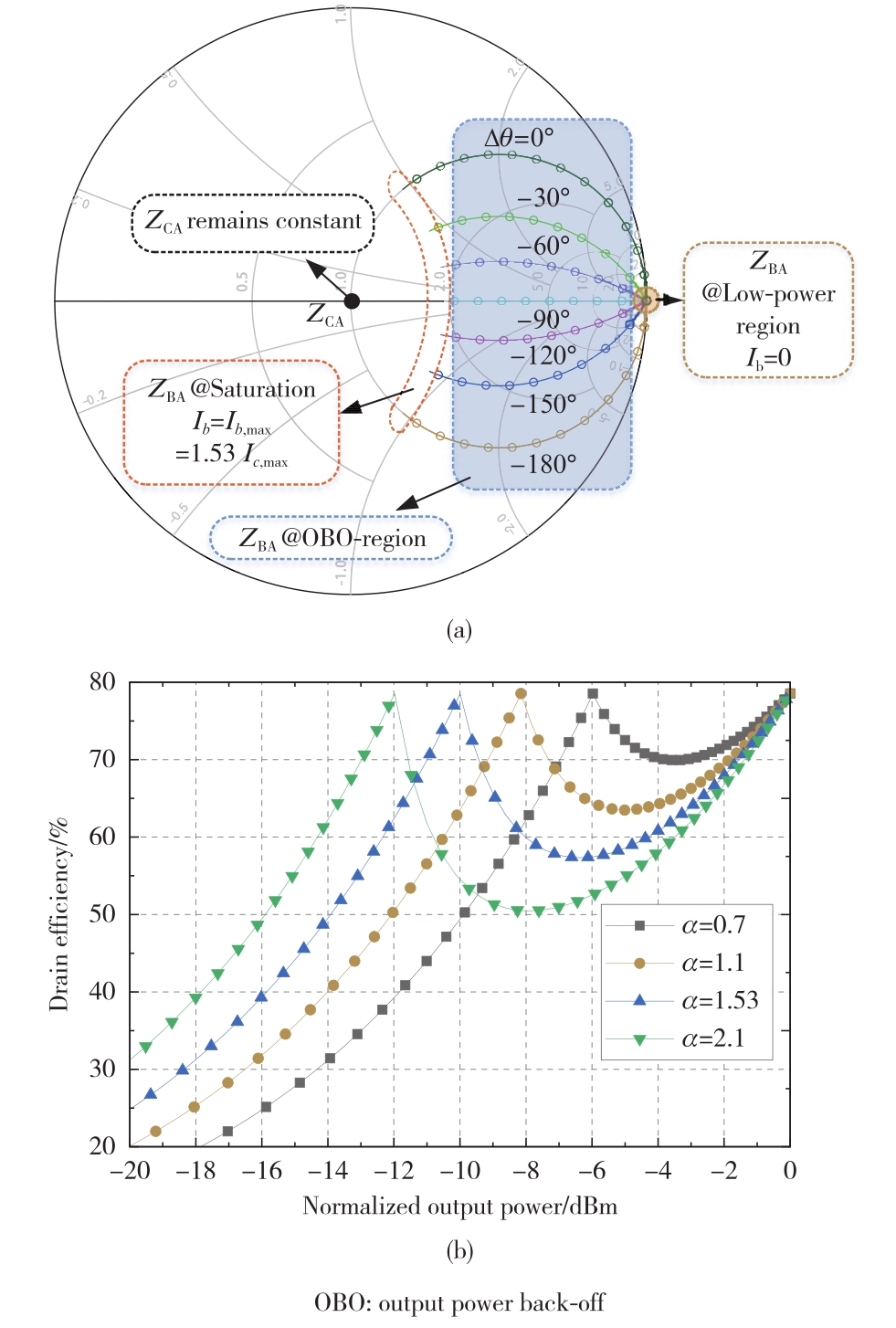ZTE Communications ›› 2022, Vol. 20 ›› Issue (4): 62-68.DOI: 10.12142/ZTECOM.202204008
• Research Paper • Previous Articles Next Articles
RAN Xiongbo, DAI Zhijiang( ), ZHONG Kang, PANG Jingzhou, LI Mingyu
), ZHONG Kang, PANG Jingzhou, LI Mingyu
Received:2022-06-20
Online:2022-12-31
Published:2022-12-30
Contact:
DAI Zhijiang
About author:RAN Xiongbo received his BSc degree in electronic engineering from the Hangzhou Dianzi University, China in 2019, and MSc degree in electronic engineering from the School of Microelectronics and Communication Engineering, Chongqing University, China in 2022. His research interests include microwave and millimeter-wave devices and circuits, and wideband high-efficiency power amplifier design.|DAI Zhijiang (Supported by:RAN Xiongbo, DAI Zhijiang, ZHONG Kang, PANG Jingzhou, LI Mingyu. Broadband Sequential Load-Modulated Balanced Amplifier Using Coupler-PA Co-Design Approach[J]. ZTE Communications, 2022, 20(4): 62-68.

Figure 2 (a) Load impedance traces of sequential load-modulated balanced amplifier (SLMBA) (OBO=10 dB) and (b) drain efficiency curves of SLMBA at different values of α

Figure 8 Simulation results of the sequential load-modulated balanced amplifier (SLMBA)[7] PEDNEKAR P H, BERRY E, BARTON T W. RF-input load modulated balanced amplifier with octave bandwidth [J]. IEEE transactions on microwave theory and techniques, 2017, 65(12): 5181–5191. DOI: 10.1109/TMTT.2017.2748123[8] QUAGLIA R, CRIPPS S. A load modulated balanced amplifier for telecom applications [J]. IEEE transactions on microwave theory and techniques, 2018, 66(3): 1328–1338. DOI: 10.1109/TMTT.2017.2766066[9] PANG J, LI Y, LI M, et al. Analysis and design of highly efficient wideband RF-input sequential load modulated balanced power amplifier [J]. IEEE transactions on microwave theory and techniques, 2020, 68(5): 1741–1753. DOI: 10.1109/TMTT.2019.2963868[10] CAO Y, CHEN K. Pseudo-doherty load-modulated balanced amplifier with wide bandwidth and extended power back-off range [J]. IEEE transactions on microwave theory and techniques, 2020, 68(7): 3172–3183. DOI: 10.1109/TMTT.2020.2983925[11] PANG J, CHU C, LI Y, et al. Broadband RF-input continuous-mode load-modulated balanced power amplifier with input phase adjustment [J]. IEEE transactions on microwave theory and techniques, 2020, 68(10): 4466–4478. DOI: 10.1109/TMTT.2020.3012141[12] Y. CAO Y, LYU H, CHEN K. Asymmetrical load modulated balanced amplifier with continuum of modulation ratio and dual-octave bandwidth [J]. IEEE transactions on microwave theory and techniques, 2021, 69(1): 682–696. DOI: 10.1109/TMTT.2020.3014616[13] CAO Y, CHEN K. Pseudo-doherty load-modulated balanced amplifier with wide bandwidth and extended power back-off range [J]. IEEE transactions on microwave theory and techniques, 2020, 68(7): 3172–3183. DOI: 10.1109/TMTT.2020.2983925
| 1 |
PANG J, HE S, HUANG C, et al. A post-matching doherty power amplifier employing low-order impedance inverters for broadband applications [J]. IEEE transactions on microwave theory and techniques, 2015, 63(12): 4061–4071. DOI: 10.1109/TMTT.2015.2495201
DOI |
| 2 |
KANG H, LEE H, LEE W, et al. Octave bandwidth doherty power amplifier using multiple resonance circuit for the peaking amplifier [J]. IEEE transactions on circuits and systems I: regular papers, 2019, 66(2): 583–593. DOI: 10.1109/TCSI.2018.2869905
DOI |
| 3 |
MOON J, KIM J, KIM J, et al. Efficiency enhancement of doherty amplifier through mitigation of the knee voltage effect [J]. IEEE transactions on microwave theory and techniques, 2011, 59(1): 143–152. DOI: 10.1109/TMTT.2010.2091207
DOI |
| 4 |
COLANTONIO P, GIANNINI F, GIOFRE R, et al. Increasing doherty amplifier average efficiency exploiting device knee voltage behavior [J]. IEEE transactions on microwave theory and techniques, 2011, 59(9): 2295–2305. DOI: 10.1109/TMTT.2011.2160278
DOI |
| 5 |
FANG X-H, LIU H-Y, CHENG K-K M, et al. Two-way doherty power amplifier efficiency enhancement by incorporating transistors' nonlinear phase distortion [J]. IEEE microwave and wireless components letters, 2018, 28(2): 168–170. DOI: 10.1109/LMWC.2017.2783845
DOI |
| 6 |
SHEPPHARD D J, POWELL J, CRIPPS S C. An efficient broadband reconfigurable power amplifier using active load modulation [J]. IEEE microwave and wireless components letters, 2016, 26(6): 443–445. DOI: 10.1109/LMWC.2016.2559503
DOI |
| [1] | REN Fang, LI Yidan, YE Bing, LIU Jianguo, CHEN Weizhang. Real-Time 4-Mode MDM Transmission Using Commercial 400G OTN Transceivers and All-Fiber Mode Multiplexers [J]. ZTE Communications, 2024, 22(1): 106-110. |
| [2] | SHEN Jun, ZHAO Tianxiang, LIU Xueguan. Polarization Reconfigurable Patch Antenna for Wireless Power Transfer Related Applications [J]. ZTE Communications, 2022, 20(2): 37-42. |
| [3] | LIANG Junrui, LI Xin, YANG Hailiang. Kinetic Energy Harvesting Toward Battery-Free IoT: Fundamentals, Co-Design Necessity and Prospects [J]. ZTE Communications, 2021, 19(1): 48-60. |
| [4] | ZHANG Wenmei, CHEN Xinwei. Overview of Co-Design Approach to RF Filter and Antenna [J]. ZTE Communications, 2018, 16(1): 61-66. |
| [5] | Xiongyan Tang, Pei Zhang, and Chang Cao. SDN-Based Broadband Network for Cloud Services [J]. ZTE Communications, 2014, 12(2): 18-22. |
| [6] | Ruili Wu, Jerry Lopez, Yan Li and Donald Y.C. Lie. Design Technologies for Silicon-Based High-Efficiency RF Power Amplifiers: A Brief Overview [J]. ZTE Communications, 2011, 9(3): 28-35. |
| [7] | Pengcheng Jia. Broadband Power Amplifiers for Unified Base Stations [J]. ZTE Communications, 2011, 9(2): 8-11. |
| Viewed | ||||||||||||||||||||||||||||||||||||||||||||||||||
|
Full text 166
|
|
|||||||||||||||||||||||||||||||||||||||||||||||||
|
Abstract 81
|
|
|||||||||||||||||||||||||||||||||||||||||||||||||